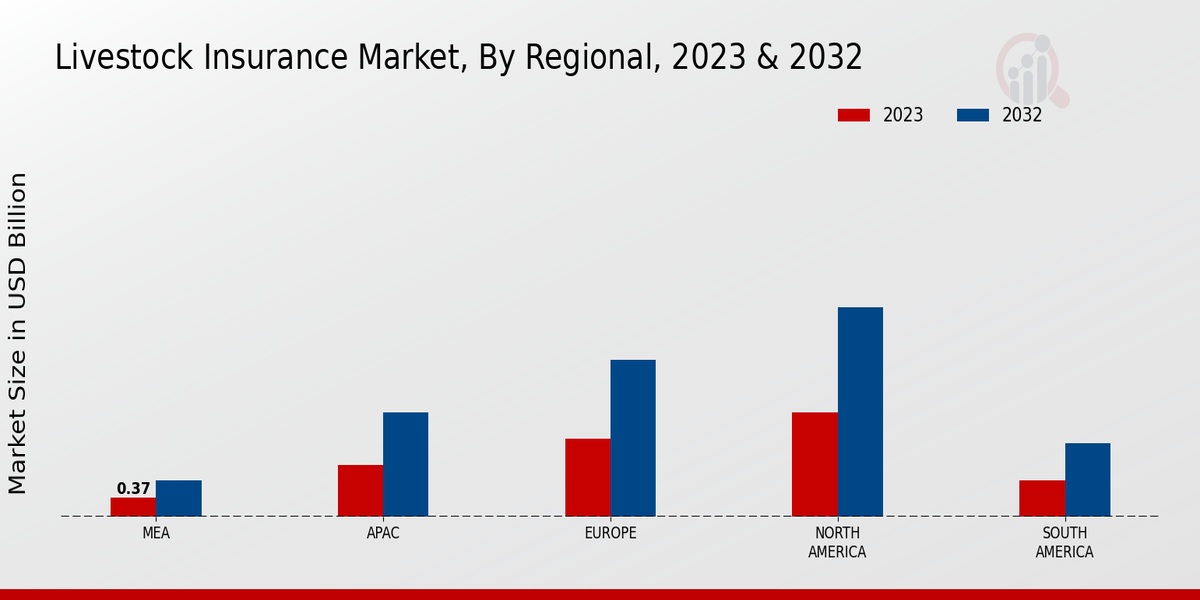Market Growth Projections
The Global Livestock Insurance Market Industry is poised for substantial growth, with projections indicating a market value of 14.2 USD Billion by 2035. This anticipated growth is underpinned by various factors, including rising demand for livestock products, technological advancements, and increased awareness of risk management. The compound annual growth rate is estimated at 7.51% from 2025 to 2035, suggesting a robust expansion trajectory. As the industry adapts to evolving challenges and opportunities, stakeholders are likely to benefit from a more dynamic and resilient market landscape.
Government Support and Subsidies
Government initiatives play a crucial role in the Global Livestock Insurance Market Industry, as many countries implement policies to support farmers through subsidies and insurance programs. These programs aim to stabilize the agricultural sector and ensure food security by providing financial assistance in the event of livestock loss. For example, various governments have introduced schemes that cover a portion of insurance premiums, making it more accessible for farmers. This support not only encourages participation in insurance programs but also fosters a more resilient agricultural economy. Such measures are expected to contribute to a compound annual growth rate of 7.51% from 2025 to 2035.
Rising Demand for Livestock Products
The Global Livestock Insurance Market Industry is experiencing a surge in demand for livestock products, driven by increasing population and changing dietary preferences. As the global population is projected to reach approximately 9.7 billion by 2050, the need for meat, dairy, and other livestock-derived products is expected to rise significantly. This growing demand necessitates the protection of livestock assets through insurance, as farmers seek to mitigate risks associated with disease outbreaks, natural disasters, and market fluctuations. Consequently, the market is projected to reach 6.41 USD Billion in 2024, reflecting the industry's response to these evolving consumer needs.
Climate Change and Environmental Risks
The impact of climate change on agriculture is prompting livestock producers to seek insurance solutions, thereby influencing the Global Livestock Insurance Market Industry. Extreme weather events, such as droughts and floods, pose significant risks to livestock health and productivity. As these environmental challenges become more frequent, farmers are increasingly turning to insurance as a means of mitigating potential losses. This shift highlights the necessity for adaptive insurance products that cater to the unique risks posed by climate change. Consequently, the market is expected to grow, with projections indicating a value of 6.41 USD Billion in 2024, reflecting the urgent need for protective measures.
Increasing Awareness of Risk Management
There is a growing awareness among livestock producers regarding the importance of risk management strategies, which is positively influencing the Global Livestock Insurance Market Industry. Farmers are increasingly recognizing that livestock insurance can serve as a vital tool to safeguard their investments against unforeseen events. Educational programs and outreach initiatives by agricultural organizations are helping to disseminate knowledge about the benefits of insurance. As producers become more informed, the demand for comprehensive insurance solutions is likely to rise, further driving market growth. This trend is anticipated to align with the overall expansion of the market, projected to reach 14.2 USD Billion by 2035.
Technological Advancements in Insurance Solutions
Innovations in technology are transforming the Global Livestock Insurance Market Industry, enabling more efficient risk assessment and management. The integration of data analytics, satellite imagery, and IoT devices allows insurers to better evaluate livestock health and environmental conditions. For instance, real-time monitoring of livestock can lead to timely interventions, reducing losses for farmers. These advancements not only enhance the accuracy of insurance products but also improve customer engagement through personalized offerings. As a result, the market is likely to expand, with projections indicating a growth to 14.2 USD Billion by 2035, driven by these technological improvements.



















